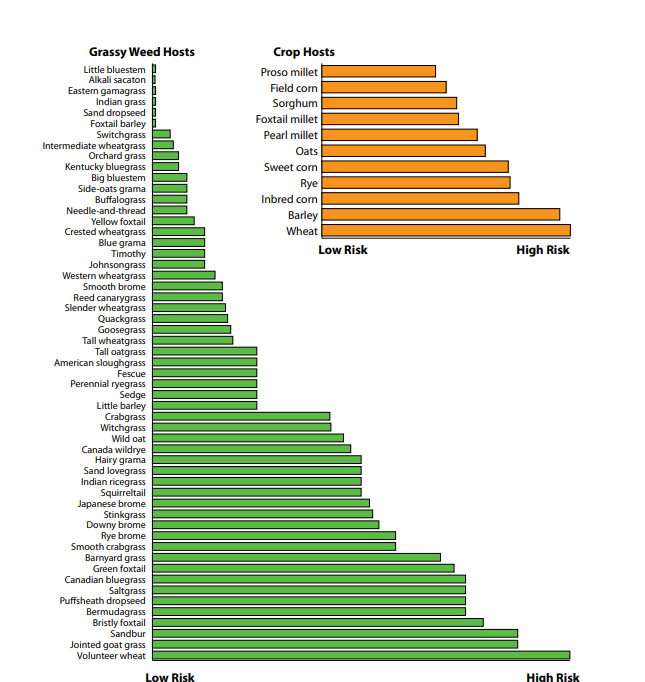
By STACY CAMPBELL
Cottonwood Extension District
This article is the second in a multi-week series on wheat streak mosaic complex management to address the 2025 outbreak.
Last week, was the recommendation for wheat-free windows. These windows include periods 30 days prior to the start of the optimal winter wheat planting window by zone in Kansas.
As the wheat curl mite is a community pest, coordinated breaks in volunteer wheat and other cereals will have the highest likelihood of lowering local and statewide mite levels moving into our 2025 optimal winter wheat planting date periods. This week, we address the role of other crops in the landscape.
Revisiting the role of other crops and weeds in the landscape
The question about the role of alternative crops and grasses in the landscape is frequently raised. The general risk of species as reservoirs for the mite and virus complex depends on several factors, including:
1. How well the curl mite reproduces on a given host,
2. How susceptible the host is to the virus,
3. The presence of the host during critical periods over the summer,
4. How those periods overlap with the wheat crop, and
5. How much of the host is present in the landscape during those critical summer months (host density)?
That information was taken together to develop the relative risk of host species to harbor wheat curl mites over the summer (Figure 2). You’ll notice that the list includes cereal crops, weeds, and pasture grasses. In all, over 90 species have been shown to harbor the mites or virus to some level. Legumes are not known hosts for the curl mite or viruses.
Volunteer wheat left over the summer is the highest risk host because it checks all the boxes for risk. The curl mites will reproduce rapidly on volunteer wheat, it is usually present right after harvest, may be left through fall planting, it is susceptible to the viruses, and it can build to high levels in the landscape. This is why the first line of defense against wheat streak will always be volunteer wheat management (ideally during wheat-free windows).
Volunteer wheat can also “hide” in summer crops planted after wheat harvest as well as cover crops, complicating the ability to determine the risk of other crops in the landscape. For example, if wheat that is harvested in June and grain sorghum (or corn and soybean) is planted into that same field after wheat harvest, secondary flushes of volunteer wheat will be difficult to control.


Winter cereals planted early (during the wheat-free windows) for grazing or cover cropping may pose a risk for harboring curl mites. Species like barley, oats, rye, and triticale have all been shown to host both the mites and the virus at fairly high levels.
When at all possible, early planting of these crops near fields that will be established with a fall wheat crop should be avoided. Including these crops in a summer cover crop mix can also be risky for bridging the curl mites and viruses to the fall wheat crop.
To a lesser extent, corn and sorghum can also host the mite and virus complex. These crops are generally considered of low concern for epidemics in Kansas.
Most of the research that we’ve reviewed has demonstrated that these crops are most conducive to curl mite survival during early growth stages.
So, for example, corn/sorghum at a young stage when wheat is drying down would be at higher risk for curl mites than late-planted corn. It appears that curl mites are limited to corn husks later in the season and can result in symptoms of kernel red streak through feeding damage. Kernel red streak is generally considered a cosmetic issue in corn, but can serve as a sign that curl mites were present.
Most commercial corn hybrids are resistant to wheat streak mosaic virus and High Plains wheat mosaic virus and will not experience yield losses to those viruses. Importantly, it appears that curl mite populations rapidly decline in the corn crop after the crop reaches black layer.
Weedy grass hosts (detailed in Figure 2) are generally a lower concern, unless they are allowed to build to high levels and remain established through the summer months. Their role in epidemics is dictated by their abundance and the time they are allowed to persist in the landscape.
Information provided by Kelsey Andersen Onofre, Extension Wheat Pathologist.
Stacy Campbell is a Crop Production Extension agent in the Cottonwood District (which includes Barton and Ellis counties) for K-State Research and Extension. You can contact him by e-mail at [email protected] or by calling 785-628-9430.






